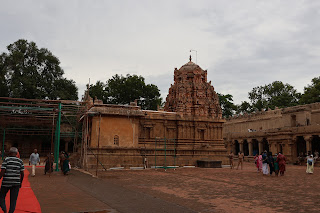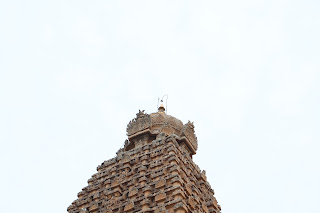Brihadishvara Temple, called Rajarajesvaram (lit. 'Lord of Rajaraja') by its
builder, is a Shaivite Hindu temple built in a Chola architectural style
located on the south bank of the Cauvery river in Thanjavur, Tamil Nadu,
India.
Built using granite, the vimana tower above the shrine is one of the tallest
in South India. The temple has a massive colonnaded prakara (corridor) and one
of the largest Shiva lingas in India. It is also famed for the quality of its
sculpture, as well as being the location that commissioned the brass Nataraja,
Shiva as the lord of dance, in the 11th century.
|
Plan of Brihadishvara Temple
Plan Legend:
- Maratha Entrance
- Keralantakan Tiruvasal
- Rajarajan Tiruvasal
- Nandi Mandapan
- Varahi shrine
- South Cloister Mandapan
- Brihadisvara Temple
- Interpretation Center
- Ganesha Shrine
- Karuvur Devar Shrine
- Subrahmanya Shrine
- Chandikesvara Shrine
- North Cloister Mandapam
- Amman Shrine
- Nataraja Mandapam
|
|
Keralantakan tiruvasal gopuram (Plan No. 2)
The temple faces
east, and once had a water moat around it. This has been filled up. The
fortified wall now runs around this moat. The two walls have ornate
gateways called the gopurams. These are made from stone and display
entablature.
- The main gateways are on the east side.
-
The first one is called the Keralantakan tiruvasal, which means the
"sacred gate of the Keralantakan".
-
The word Keralantakan was the surname of king Rajaraja who built it.
|
|
Rajarajan tiruvasal gopuram (Plan No. 3)
About a 100 metres
(330 ft) ahead is the inner courtyard gopuram called the Rajarajan
tiruvasal.
-
This is more decorated than the Keralantakan tiruvasal, such as with
its adhishthanam relief work narrating scenes from the Puranas and
other Hindu texts.
|
|
Courtyard
The inner eastern gopuram leads to a vast
courtyard, in which the shrines are all signed to east–west and
north-west cardinal directions.
|
|
Rajarajan tiruvasal gopuram seen from west
|
|
The main Vimana (Shikhara) (Plan No. 7)
The main Vimana
(Shikhara) is a massive 16 storeys tower of which 13 are tapering
squares.
- It dominates the main quadrangle.
- It sits above a 30.18 m (99.0 ft) sided square.
-
The tower is elaborately articulated with Pilaster, piers (a raised
structure), and attached columns which are placed rhythmically
covering every surface of the vimana.
|
|
Nandi mandapam (Plan No. 4)
The Nandi mandapam has a
monolithic seated bull facing the sanctum.
-
In between them are stairs leading to a columned porch and community
gathering hall, then an inner mandapa connecting to the pradakshina
patha, or circumambulation path.
-
The Nandi (bull) facing the mukh-mandapam weighs about 25 tonnes.
-
It is made of a single stone and is about 2 m (6.5 ft) in height, 6 m
(19.6 ft) in length and 2.5 m (8.2 ft) in width.
-
The image of Nandi is a monolithic one and is one of the largest in
the country.
|
|
Brihadisvara Temple seen from east (Plan No. 7)
The sanctum
is at the center of the western square.
-
It is surrounded by massive walls that are divided into levels by
sharply cut sculptures and pilasters providing deep bays and recesses.
- Each side of the sanctuary has a bay with iconography.
|
|
Southern wall of the main Vimana (Shikhara)
|
|
Ganesha Shrine (Plan No. 9)
Separate Ganesha shrine with
temple corridor in the back.
|
|
Karuvur Devar Shrine (Plan No. 10)
|
|
Main Vimana (Shikhara) seen from northwest
|
|
Main sikhara
The sikhara, a cupolic dome (25 tons), is
octagonal and rests on a single block of granite, weighing 80 tons.
|
|
Panorama of the south side of Subrahmanya Shrine (Plan No. 11)
Subrahmanyar shrine in the north part of the courtyard.
- Also called "Murugan", "Kartikeya" or "Skanda".
|
|
Vimana (Shikhara) south side of Subrahmanya Shrine
|
|
South entrance staircase to Subrahmanya Shrine
|
|
Guardians (Dvarapala) of the door of Subrahmanya Shrine
|
|
East entrance to Subrahmanya Shrine
|
|
Chandeshvara Shrine (Plan No. 12)
On right is the wall of
main temple, in back the eastern gopuram.
-
Chandeshvara is a meditating yogi and Nayanmar Bhakti movement saint.
|
|
Drainage channel of the main shrine
|
|
North wall of the main shrine
|
|
Statues at the entrance to the main shrine (Plan No. 7)
|
|
Guardians (Dvarapala) at the entrance to the main shrine
|
|
Nandi mandapan seen from west (Plan No. 4)
|
|
Nandi mandapan seen from south
|
|
Nandi mandapan seen from east
The ceremony in which Hindu
priests bathe the statue of Nandi is called Mahabhisheka or Abhisheka.
-
During this ritual, the statue is bathed with various sacred
substances such as milk, water, tender coconut water, sugarcane juice,
sandal paste, vermillion, curds, ghee, honey, and more.
-
The bathing of the deity's statue, including Nandi, symbolizes the
purification of the idol and the invitation of divine blessings. The
ritual is believed to cleanse the idol of any impurities and bless the
devotees who participate or witness the ceremony.
-
The ritual demonstrates deep devotion and reverence towards the deity.
It’s a way for devotees to express their love, respect, and gratitude.
-
The chanting of mantras and the offering of sacred substances create a
powerful spiritual atmosphere, enhancing the connection between the
devotees and the divine.
-
The substances used, like milk and honey, are considered pure and
auspicious in Hinduism. Their use in the ritual sanctifies not only
the idol but the entire environment, spreading positive energy.
|
|
Ritual Procedures:
-
Preparation: The idol of Nandi is cleaned and decorated with
flowers and garlands.
-
Invocation: Priests chant mantras and prayers to invoke the
presence of the deity.
-
Bathing (Abhisheka): The idol is bathed with a series of sacred
substances like water, milk, curds, ghee, honey, and others in a
specific order.
-
Offerings: After the bath, other offerings such as flowers,
incense, and fruits are made.
-
Decoration: The idol is then adorned with fresh clothes,
jewelry, and flowers.
-
Aarti: The ceremony usually ends with an Aarti (a ritual of
worship with light), where devotees sing hymns and wave lit lamps in
front of the deity.
-
Prasad Distribution: After the ritual, the offerings are
distributed among the devotees as Prasad (blessed food).
|
See Also
Source
Location
Thanjavur Maratha Palace - Nataraja Hall
Thanjavur Maratha Palace - Nayak's Durbar Hall
Thanjavur Art Village

















































